#badashanren
Photo

A collection of 82 high-resolution digital images of Bada Shanren (Zhu Da) /八大山人
▶️https://boywithflower.gumroad.com/l/jscia
▶️https://www.boywithflowers.com/product/bada-shanren/
▶️https://www.patreon.com/posts/64366632
Get more digital paintings.
https://boywithflower.gumroad.com/
https://www.boywithflowers.com
https://www.patreon.com/boy_with_flowers_art_gallery
1 note
·
View note
Text
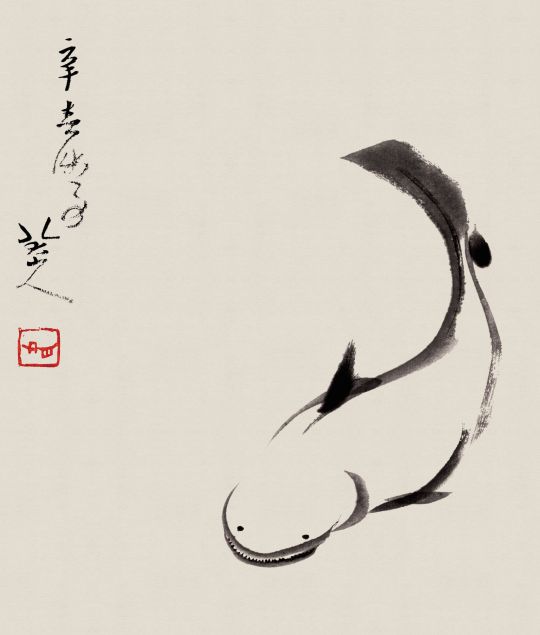
fish with teeth :E
Fish by Badashanren 朱耷 (1626-1705)
12 notes
·
View notes
Photo

清 朱耷 (八大山人) 李治書 扇頁|Letter by Li Zhi by Bada Shanren, Asian Art
Medium: Folding fan mounted as an album leaf; ink on paper
Bequest of John M. Crawford Jr., 1988 Metropolitan Museum of Art, New York, NY
http://www.metmuseum.org/art/collection/search/49146
2 notes
·
View notes
Photo

sangcheng week 2020 // day 3 - yearning / "lotus and birds" - badashanren
colours by @dapacchicode 🌿
the poem here’s from “the song of bamboo twigs” by liu yuxi, translation here
#sangcheng#sangchengweek2020#scweek2020#jiang cheng#nie huaisang#dapacchicode#collab#theresa draws#(throws all the sangcheng symbolism at this piece)
628 notes
·
View notes
Photo
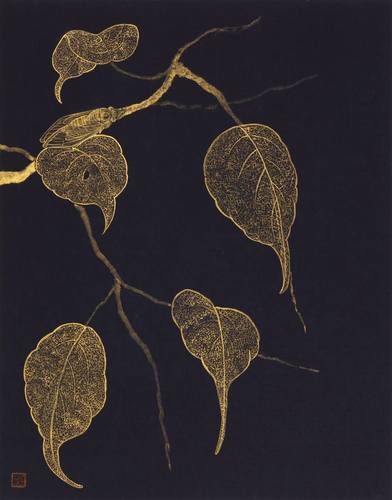
Prayer of A Cicada, HyunJung Kim
Drawing: goldpowder and realgold on Paper. Heaviness wrapped up with Lightness – Reading Kim HyunJung’s painting Lee DongChun (Fine art Connoisseur) Kim HyunJung’s paintings are cute and interesting. Her painting reminds us of paintings by Qi Baishi 齐白石 (1864-1957). Qi Baishi pursued beauty in his life, and his artistic spirit is found in his plant-and-insect paintings, flower-and-bird paintings, and figure paintings. Qi Baishi’s artistic spirit is sensed in Kim’s interesting subject matter and candid depiction.Kim audaciously uses ink and bright hues in in the manner of Qi Baishi who applied ink to leaves and red to flowers 墨叶红花. The composition in which subject matter is drawn to the edge of the paper is parallel to that of Qi Baishi’s flower-and-bird paintings and landscape painting of Li Keran’s 李可染 (1907-1989). Kim obviously learned from Qi Baishi. Qi Baishi said, “Learn from me you stand, copy from me you fall 学我者生, 似我者死.” Kim modeled herself after Qi’s artistic spirit rather than his painting style. Kim explored the artistic spirit in Qi Baishi’s painting, in which he emphasizes the meaning of painting and expresses his spirit, and reconstructed this in a realistic rendition. She calls this the “chulsa-ipgong 出写入工” technique. This is a melding of “xieyi 写意” painting (painting that underlines the painter’s spirit), “gongbi-hwa 工笔画” (painting done very carefully with the utmost care for details), and a new invention in tune with her emotion. Zheng Xie 郑燮 (1693-1765), one of the Eight Eccentrics of Yangzhou during the Qing Dynasty asserted, “Learn half, and throw away half 学一半, 撇一半.” This means even if a tradition is excellent, you have to learn only half of it. However, the traditional is currently completely disregarded. Kim learned her ‘half’ from traditional Eastern techniques. She studied the idioms of flower-and-bird painting from Song Dynasty, and learned from artists such as Chen HongShou 陈洪绶 (1599-1652), Yun ShouPing 恽寿平 (1633-1690), ShiTao 石涛 (1641-1707), BaDaShanRen 八大山人 (1625-1705), Gao QiPei 高其佩 (1660-1734), Jin Nong 金农 (1687-1764), and Kim HongDo 金弘道 (1745-1806). Moreover, she explored new methods in expression of color in traditional techniques. As she felt insufficiency in the use of pigment to depict significant parts of a painting, she made use of embroidery. This technique called “hwaju-subo 画主绣补” (Paining is used as primary and embroidery as ancillary) brought a new vitality to gongbi-hwa. The techniques of “chulsa-ipgong” and “hwaju-subo” are not the only revolution and innovation Kim has pursued. Getting psychological counselling, Kim realized the existence of her inner-child. She named her “Lala” and represented her special emotion in a pictorial language through this. Her Lala painting is a projection of her inner-child that she became aware of through psychological consultation, and for the artist a process of healing. This painting is in no way the product of pop art, but the sublimation of an artist’s inner-child to a work of art for the first time in art history. Kim’s Finding implicit rules is a portrayal of a young girl in meditation. The little girl carrying Lala on her back gazes vacantly at a dragonfly on a bare branch against the backdrop of a brick wall. Lala and the little girl look cute. The brick wall is a metaphor for constant time whereas the bare branches and dragonfly represent finite time in nature. The dragonfly acts out as the last leaf by O. Henry (William Sydney Porter, 1862-1910). As a projection of a psychological essay in painting, this work is a new literati painting of the 21st century reflecting Kim’s distinctive art-world. Kim lends new energy to gongbi-hwa through her realization of traditional Eastern painting. Kim has incarnated the spiritual world of intellectuals in our age in exquisite, flamboyant gongbi-hwa. This is why Chinese aestheticians and art historians have recently taken note of Kim’s painting.
https://www.saatchiart.com/art/Painting-Prayer-of-A-Cicada/960197/3943611/view
4 notes
·
View notes
Text
In vel commodo ex
Lorem ipsum dolor sit amet, consectetur adipiscing elit. Duis tempus ut sapien condimentum fringilla. Mauris commodo felis nec egestas rutrum. Donec semper convallis libero, mollis malesuada X02hRetCp Soulmates Paperback nibh ullamcorper interdum. Nullam eget nisi pharetra, posuere arcu non, aliquet sapien. Curabitur blandit condimentum lacus quis consectetur. In quis hendrerit sem. Donec laoreet velit nisi, id pellentesque sapien lacinia facilisis. Nunc ut scelerisque risus, at sollicitudin leo. Pellentesque nulla massa, ornare nec interdum sed, rutrum vel dui. Integer vestibulum quam in lacus eleifend, in porta nisi sodales. Nullam vehicula rhoncus lorem eu fermentum. Proin ut feugiat ex. Morbi consequat nulla ipsum.
Praesent dapibus elementum nunc TPx9bpq0k09M The Sufferings Of Young Werther A New Translatio 1, nec eleifend magna consequat porta. Morbi vitae felis efficitur, ultrices tellus quis, sagittis nisl. Vivamus gravida urna eget sem vehicula maximus ornare in felis. Aliquam massa urna, tempor nec erat vitae, sodales semper ipsum. Aenean interdum est et tortor facilisis sagittis. Aenean aliquam dictum eros, ac tempus tellus sollicitudin vitae. Donec vitae sapien ac leo dictum laoreet. Mauris tincidunt urna justo, sed aliquam nulla aliquet sit amet. #####Integer in erat vitae tortor suscipit hendrerit eu et urna. Nam et neque hendrerit, bibendum ligula non, malesuada lectus.
Duis hendrerit, nisl sed imperdiet consectetur, erat velit dignissim lacus, nec pretium enim tellus quis ex.
Integer rhoncus nunc sed turpis tincidunt vulputate 8ay77QaooITA The Bad Boys Of The Bible 7 Most Infamous Paperb. Nullam fermentum sapien eu risus sodales maximus. In vel commodo ex. Ut a turpis at risus fringilla tincidunt placerat non orci. Donec viverra, risus sit amet aliquam dapibus, est purus dictum velit, eu scelerisque lectus nibh ac sapien. In sem massa, tincidunt eu lorem eleifend, rhoncus tincidunt augue. Integer porta nunc nec nisi maximus, sed volutpat leo bibendum. Proin suscipit tortor leo, sit amet tempus velit ultrices et. Fusce aliquet mauris nisl, non euismod augue mollis ultrices. Pellentesque eu lectus elit.
The police officers are interrogating the suspect, although they have not arrested anybody.
Nunc et mauris purus. In scelerisque libero vel turpis imperdiet auctor. Aliquam pellentesque purus sed ante elementum tempor. Cras accumsan tellus at tortor vestibulum rutrum. Mauris sit amet bibendum tellus, tristique iaculis sapien. Aliquam sit amet sem eget felis suscipit tincidunt. Vestibulum fermentum condimentum malesuada. Nullam tellus lectus, finibus in ex id BX7YzK4S Badashanren Bird Atlas Chinese Edition, venenatis aliquet lectus. Cras pretium pretium purus, non luctus lectus pulvinar non. Sed nec neque at mi finibus luctus sit amet in lectus. Integer sodales fringilla sapien rutrum egestas. Fusce interdum convallis dolor. In ac erat ullamcorper, pharetra elit quis, iaculis risus. Donec ultrices sapien vitae consectetur elementum. In id sem vel nisl vulputate tempor.
Nunc urna nisi, volutpat vel enim non, sollicitudin auctor purus. Nam in mattis sem. Fusce non ultricies neque. Duis egestas magna eget finibus auctor. Praesent euismod iaculis velit quis interdum. Nulla ultricies magna non elit volutpat sagittis N4CFHuA6S6J C . Mauris diam ligula, pharetra quis ipsum pharetra, bibendum congue orci. Maecenas aliquet, ipsum mollis lacinia lobortis, velit tellus lobortis odio, nec consectetur tellus mauris convallis nisl.
0 notes
Photo





http://en.wikipedia.org/wiki/Bada_Shanren
八大山人
23 notes
·
View notes
Text

Lotus by Badashanren 朱耷 (1626-1705)
Splash ink painting, free will and self constrain at the same time
7 notes
·
View notes
Photo
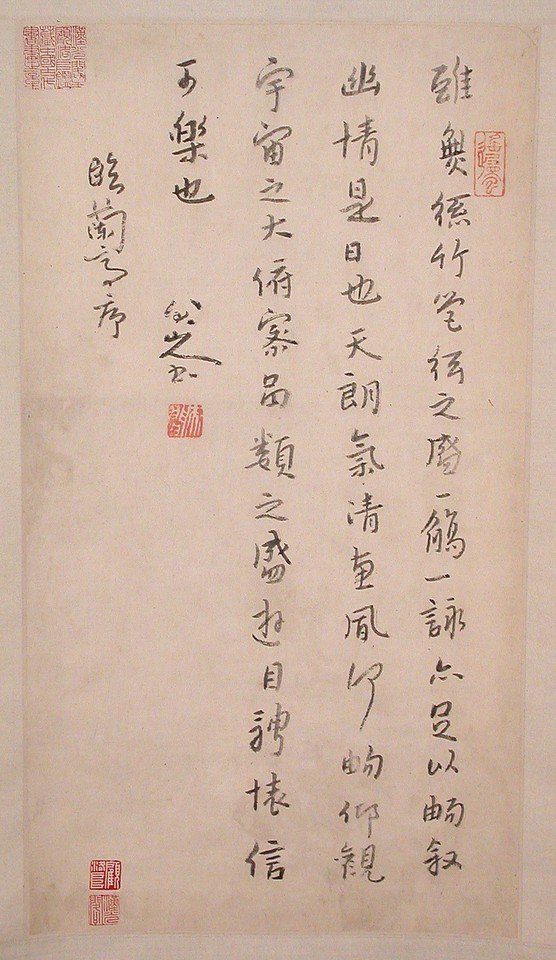
清 朱耷 (八大山人) 倣王羲之 蘭亭序 軸|After Wang Xizhi's (303?-361?) "Preface to the Orchid Pavilion Gathering" by Bada Shanren via Asian Art
Medium: Hanging scroll; ink on paper
Bequest of John M. Crawford Jr., 1988 Metropolitan Museum of Art, New York, NY
http://www.metmuseum.org/art/collection/search/49144
1 note
·
View note
Photo

Veil, HyunJung Kim
Heaviness wrapped up with Lightness – Reading Kim HyunJung’s painting Lee DongChun (Fine art Connoisseur) Kim HyunJung’s paintings are cute and interesting. Her painting reminds us of paintings by Qi Baishi 齐白石 (1864-1957). Qi Baishi pursued beauty in his life, and his artistic spirit is found in his plant-and-insect paintings, flower-and-bird paintings, and figure paintings. Qi Baishi’s artistic spirit is sensed in Kim’s interesting subject matter and candid depiction.Kim audaciously uses ink and bright hues in in the manner of Qi Baishi who applied ink to leaves and red to flowers 墨叶红花. The composition in which subject matter is drawn to the edge of the paper is parallel to that of Qi Baishi’s flower-and-bird paintings and landscape painting of Li Keran’s 李可染 (1907-1989). Kim obviously learned from Qi Baishi. Qi Baishi said, “Learn from me you stand, copy from me you fall 学我者生, 似我者死.” Kim modeled herself after Qi’s artistic spirit rather than his painting style. Kim explored the artistic spirit in Qi Baishi’s painting, in which he emphasizes the meaning of painting and expresses his spirit, and reconstructed this in a realistic rendition. She calls this the “chulsa-ipgong 出写入工” technique. This is a melding of “xieyi 写意” painting (painting that underlines the painter’s spirit), “gongbi-hwa 工笔画” (painting done very carefully with the utmost care for details), and a new invention in tune with her emotion. Zheng Xie 郑燮 (1693-1765), one of the Eight Eccentrics of Yangzhou during the Qing Dynasty asserted, “Learn half, and throw away half 学一半, 撇一半.” This means even if a tradition is excellent, you have to learn only half of it. However, the traditional is currently completely disregarded. Kim learned her ‘half’ from traditional Eastern techniques. She studied the idioms of flower-and-bird painting from Song Dynasty, and learned from artists such as Chen HongShou 陈洪绶 (1599-1652), Yun ShouPing 恽寿平 (1633-1690), ShiTao 石涛 (1641-1707), BaDaShanRen 八大山人 (1625-1705), Gao QiPei 高其佩 (1660-1734), Jin Nong 金农 (1687-1764), and Kim HongDo 金弘道 (1745-1806). Moreover, she explored new methods in expression of color in traditional techniques. As she felt insufficiency in the use of pigment to depict significant parts of a painting, she made use of embroidery. This technique called “hwaju-subo 画主绣补” (Paining is used as primary and embroidery as ancillary) brought a new vitality to gongbi-hwa. The techniques of “chulsa-ipgong” and “hwaju-subo” are not the only revolution and innovation Kim has pursued. Getting psychological counselling, Kim realized the existence of her inner-child. She named her “Lala” and represented her special emotion in a pictorial language through this. Her Lala painting is a projection of her inner-child that she became aware of through psychological consultation, and for the artist a process of healing. This painting is in no way the product of pop art, but the sublimation of an artist’s inner-child to a work of art for the first time in art history. Kim’s Finding implicit rules is a portrayal of a young girl in meditation. The little girl carrying Lala on her back gazes vacantly at a dragonfly on a bare branch against the backdrop of a brick wall. Lala and the little girl look cute. The brick wall is a metaphor for constant time whereas the bare branches and dragonfly represent finite time in nature. The dragonfly acts out as the last leaf by O. Henry (William Sydney Porter, 1862-1910). As a projection of a psychological essay in painting, this work is a new literati painting of the 21st century reflecting Kim’s distinctive art-world. Kim lends new energy to gongbi-hwa through her realization of traditional Eastern painting. Kim has incarnated the spiritual world of intellectuals in our age in exquisite, flamboyant gongbi-hwa. This is why Chinese aestheticians and art historians have recently taken note of Kim’s painting.
https://www.saatchiart.com/art/Painting-Veil/960197/3943575/view
1 note
·
View note
Photo
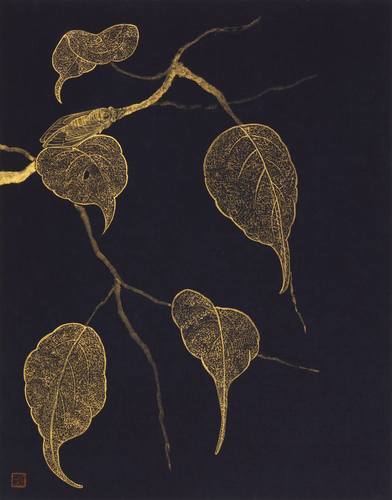
Prayer of A Cicada, HyunJung Kim
Drawing: goldpowder and realgold on Paper. Heaviness wrapped up with Lightness – Reading Kim HyunJung’s painting Lee DongChun (Fine art Connoisseur) Kim HyunJung’s paintings are cute and interesting. Her painting reminds us of paintings by Qi Baishi 齐白石 (1864-1957). Qi Baishi pursued beauty in his life, and his artistic spirit is found in his plant-and-insect paintings, flower-and-bird paintings, and figure paintings. Qi Baishi’s artistic spirit is sensed in Kim’s interesting subject matter and candid depiction.Kim audaciously uses ink and bright hues in in the manner of Qi Baishi who applied ink to leaves and red to flowers 墨叶红花. The composition in which subject matter is drawn to the edge of the paper is parallel to that of Qi Baishi’s flower-and-bird paintings and landscape painting of Li Keran’s 李可染 (1907-1989). Kim obviously learned from Qi Baishi. Qi Baishi said, “Learn from me you stand, copy from me you fall 学我者生, 似我者死.” Kim modeled herself after Qi’s artistic spirit rather than his painting style. Kim explored the artistic spirit in Qi Baishi’s painting, in which he emphasizes the meaning of painting and expresses his spirit, and reconstructed this in a realistic rendition. She calls this the “chulsa-ipgong 出写入工” technique. This is a melding of “xieyi 写意” painting (painting that underlines the painter’s spirit), “gongbi-hwa 工笔画” (painting done very carefully with the utmost care for details), and a new invention in tune with her emotion. Zheng Xie 郑燮 (1693-1765), one of the Eight Eccentrics of Yangzhou during the Qing Dynasty asserted, “Learn half, and throw away half 学一半, 撇一半.” This means even if a tradition is excellent, you have to learn only half of it. However, the traditional is currently completely disregarded. Kim learned her ‘half’ from traditional Eastern techniques. She studied the idioms of flower-and-bird painting from Song Dynasty, and learned from artists such as Chen HongShou 陈洪绶 (1599-1652), Yun ShouPing 恽寿平 (1633-1690), ShiTao 石涛 (1641-1707), BaDaShanRen 八大山人 (1625-1705), Gao QiPei 高其佩 (1660-1734), Jin Nong 金农 (1687-1764), and Kim HongDo 金弘道 (1745-1806). Moreover, she explored new methods in expression of color in traditional techniques. As she felt insufficiency in the use of pigment to depict significant parts of a painting, she made use of embroidery. This technique called “hwaju-subo 画主绣补” (Paining is used as primary and embroidery as ancillary) brought a new vitality to gongbi-hwa. The techniques of “chulsa-ipgong” and “hwaju-subo” are not the only revolution and innovation Kim has pursued. Getting psychological counselling, Kim realized the existence of her inner-child. She named her “Lala” and represented her special emotion in a pictorial language through this. Her Lala painting is a projection of her inner-child that she became aware of through psychological consultation, and for the artist a process of healing. This painting is in no way the product of pop art, but the sublimation of an artist’s inner-child to a work of art for the first time in art history. Kim’s Finding implicit rules is a portrayal of a young girl in meditation. The little girl carrying Lala on her back gazes vacantly at a dragonfly on a bare branch against the backdrop of a brick wall. Lala and the little girl look cute. The brick wall is a metaphor for constant time whereas the bare branches and dragonfly represent finite time in nature. The dragonfly acts out as the last leaf by O. Henry (William Sydney Porter, 1862-1910). As a projection of a psychological essay in painting, this work is a new literati painting of the 21st century reflecting Kim’s distinctive art-world. Kim lends new energy to gongbi-hwa through her realization of traditional Eastern painting. Kim has incarnated the spiritual world of intellectuals in our age in exquisite, flamboyant gongbi-hwa. This is why Chinese aestheticians and art historians have recently taken note of Kim’s painting.
https://www.saatchiart.com/art/Painting-Prayer-of-A-Cicada/960197/3943611/view
11 notes
·
View notes
Photo
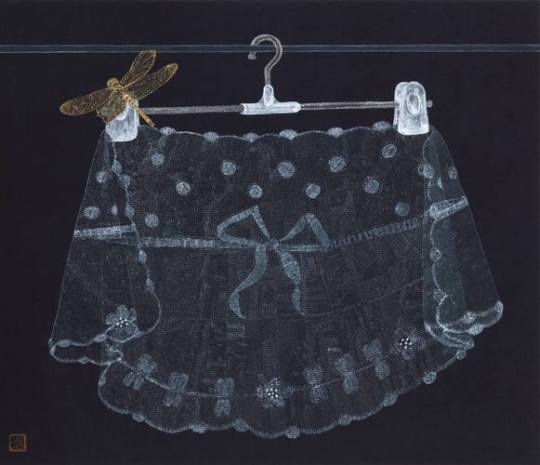
Veil, HyunJung Kim
Heaviness wrapped up with Lightness – Reading Kim HyunJung’s painting Lee DongChun (Fine art Connoisseur) Kim HyunJung’s paintings are cute and interesting. Her painting reminds us of paintings by Qi Baishi 齐白石 (1864-1957). Qi Baishi pursued beauty in his life, and his artistic spirit is found in his plant-and-insect paintings, flower-and-bird paintings, and figure paintings. Qi Baishi’s artistic spirit is sensed in Kim’s interesting subject matter and candid depiction.Kim audaciously uses ink and bright hues in in the manner of Qi Baishi who applied ink to leaves and red to flowers 墨叶红花. The composition in which subject matter is drawn to the edge of the paper is parallel to that of Qi Baishi’s flower-and-bird paintings and landscape painting of Li Keran’s 李可染 (1907-1989). Kim obviously learned from Qi Baishi. Qi Baishi said, “Learn from me you stand, copy from me you fall 学我者生, 似我者死.” Kim modeled herself after Qi’s artistic spirit rather than his painting style. Kim explored the artistic spirit in Qi Baishi’s painting, in which he emphasizes the meaning of painting and expresses his spirit, and reconstructed this in a realistic rendition. She calls this the “chulsa-ipgong 出写入工” technique. This is a melding of “xieyi 写意” painting (painting that underlines the painter’s spirit), “gongbi-hwa 工笔画” (painting done very carefully with the utmost care for details), and a new invention in tune with her emotion. Zheng Xie 郑燮 (1693-1765), one of the Eight Eccentrics of Yangzhou during the Qing Dynasty asserted, “Learn half, and throw away half 学一半, 撇一半.” This means even if a tradition is excellent, you have to learn only half of it. However, the traditional is currently completely disregarded. Kim learned her ‘half’ from traditional Eastern techniques. She studied the idioms of flower-and-bird painting from Song Dynasty, and learned from artists such as Chen HongShou 陈洪绶 (1599-1652), Yun ShouPing 恽寿平 (1633-1690), ShiTao 石涛 (1641-1707), BaDaShanRen 八大山人 (1625-1705), Gao QiPei 高其佩 (1660-1734), Jin Nong 金农 (1687-1764), and Kim HongDo 金弘道 (1745-1806). Moreover, she explored new methods in expression of color in traditional techniques. As she felt insufficiency in the use of pigment to depict significant parts of a painting, she made use of embroidery. This technique called “hwaju-subo 画主绣补” (Paining is used as primary and embroidery as ancillary) brought a new vitality to gongbi-hwa. The techniques of “chulsa-ipgong” and “hwaju-subo” are not the only revolution and innovation Kim has pursued. Getting psychological counselling, Kim realized the existence of her inner-child. She named her “Lala” and represented her special emotion in a pictorial language through this. Her Lala painting is a projection of her inner-child that she became aware of through psychological consultation, and for the artist a process of healing. This painting is in no way the product of pop art, but the sublimation of an artist’s inner-child to a work of art for the first time in art history. Kim’s Finding implicit rules is a portrayal of a young girl in meditation. The little girl carrying Lala on her back gazes vacantly at a dragonfly on a bare branch against the backdrop of a brick wall. Lala and the little girl look cute. The brick wall is a metaphor for constant time whereas the bare branches and dragonfly represent finite time in nature. The dragonfly acts out as the last leaf by O. Henry (William Sydney Porter, 1862-1910). As a projection of a psychological essay in painting, this work is a new literati painting of the 21st century reflecting Kim’s distinctive art-world. Kim lends new energy to gongbi-hwa through her realization of traditional Eastern painting. Kim has incarnated the spiritual world of intellectuals in our age in exquisite, flamboyant gongbi-hwa. This is why Chinese aestheticians and art historians have recently taken note of Kim’s painting.
https://www.saatchiart.com/art/Painting-Veil/960197/3943575/view
1 note
·
View note
Photo

清 朱耷 (八大山人) 山水圖 冊|Landscape album by Bada Shanren, Asian Art
Medium: Album of twelve leaves; ink and color on paper
Bequest of John M. Crawford Jr., 1988 Metropolitan Museum of Art, New York, NY
http://www.metmuseum.org/art/collection/search/49145
1 note
·
View note
Photo

明/清 朱耷(八大山人) 致方士琯書 冊 紙本|Letters to Fang Shiguan by Bada Shanren via Asian Art
Medium: Album of ten leaves; ink on patterned and plain paper
Gift of John M. Crawford Jr., 1982 Metropolitan Museum of Art, New York, NY
http://www.metmuseum.org/art/collection/search/49147
0 notes
Photo

Pryer of A Cicada / 貝葉蟬, HyunJung Kim
Heaviness wrapped up with Lightness – Reading Kim HyunJung’s painting Lee DongChun (Fine art Connoisseur) Kim HyunJung’s paintings are cute and interesting. Her painting reminds us of paintings by Qi Baishi 齐白石 (1864-1957). Qi Baishi pursued beauty in his life, and his artistic spirit is found in his plant-and-insect paintings, flower-and-bird paintings, and figure paintings. Qi Baishi’s artistic spirit is sensed in Kim’s interesting subject matter and candid depiction.Kim audaciously uses ink and bright hues in in the manner of Qi Baishi who applied ink to leaves and red to flowers 墨叶红花. The composition in which subject matter is drawn to the edge of the paper is parallel to that of Qi Baishi’s flower-and-bird paintings and landscape painting of Li Keran’s 李可染 (1907-1989). Kim obviously learned from Qi Baishi. Qi Baishi said, “Learn from me you stand, copy from me you fall 学我者生, 似我者死.” Kim modeled herself after Qi’s artistic spirit rather than his painting style. Kim explored the artistic spirit in Qi Baishi’s painting, in which he emphasizes the meaning of painting and expresses his spirit, and reconstructed this in a realistic rendition. She calls this the “chulsa-ipgong 出写入工” technique. This is a melding of “xieyi 写意” painting (painting that underlines the painter’s spirit), “gongbi-hwa 工笔画” (painting done very carefully with the utmost care for details), and a new invention in tune with her emotion. Zheng Xie 郑燮 (1693-1765), one of the Eight Eccentrics of Yangzhou during the Qing Dynasty asserted, “Learn half, and throw away half 学一半, 撇一半.” This means even if a tradition is excellent, you have to learn only half of it. However, the traditional is currently completely disregarded. Kim learned her ‘half’ from traditional Eastern techniques. She studied the idioms of flower-and-bird painting from Song Dynasty, and learned from artists such as Chen HongShou 陈洪绶 (1599-1652), Yun ShouPing 恽寿平 (1633-1690), ShiTao 石涛 (1641-1707), BaDaShanRen 八大山人 (1625-1705), Gao QiPei 高其佩 (1660-1734), Jin Nong 金农 (1687-1764), and Kim HongDo 金弘道 (1745-1806). Moreover, she explored new methods in expression of color in traditional techniques. As she felt insufficiency in the use of pigment to depict significant parts of a painting, she made use of embroidery. This technique called “hwaju-subo 画主绣补” (Paining is used as primary and embroidery as ancillary) brought a new vitality to gongbi-hwa. The techniques of “chulsa-ipgong” and “hwaju-subo” are not the only revolution and innovation Kim has pursued. Getting psychological counselling, Kim realized the existence of her inner-child. She named her “Lala” and represented her special emotion in a pictorial language through this. Her Lala painting is a projection of her inner-child that she became aware of through psychological consultation, and for the artist a process of healing. This painting is in no way the product of pop art, but the sublimation of an artist’s inner-child to a work of art for the first time in art history. Kim’s Finding implicit rules is a portrayal of a young girl in meditation. The little girl carrying Lala on her back gazes vacantly at a dragonfly on a bare branch against the backdrop of a brick wall. Lala and the little girl look cute. The brick wall is a metaphor for constant time whereas the bare branches and dragonfly represent finite time in nature. The dragonfly acts out as the last leaf by O. Henry (William Sydney Porter, 1862-1910). As a projection of a psychological essay in painting, this work is a new literati painting of the 21st century reflecting Kim’s distinctive art-world. Kim lends new energy to gongbi-hwa through her realization of traditional Eastern painting. Kim has incarnated the spiritual world of intellectuals in our age in exquisite, flamboyant gongbi-hwa. This is why Chinese aestheticians and art historians have recently taken note of Kim’s painting.
https://www.saatchiart.com/art/Drawing-Pryer-of-A-Cicada/960197/3514676/view
0 notes
Photo

Pryer of A Cicada / 貝葉蟬, HyunJung Kim
Heaviness wrapped up with Lightness – Reading Kim HyunJung’s painting Lee DongChun (Fine art Connoisseur) Kim HyunJung’s paintings are cute and interesting. Her painting reminds us of paintings by Qi Baishi 齐白石 (1864-1957). Qi Baishi pursued beauty in his life, and his artistic spirit is found in his plant-and-insect paintings, flower-and-bird paintings, and figure paintings. Qi Baishi’s artistic spirit is sensed in Kim’s interesting subject matter and candid depiction.Kim audaciously uses ink and bright hues in in the manner of Qi Baishi who applied ink to leaves and red to flowers 墨叶红花. The composition in which subject matter is drawn to the edge of the paper is parallel to that of Qi Baishi’s flower-and-bird paintings and landscape painting of Li Keran’s 李可染 (1907-1989). Kim obviously learned from Qi Baishi. Qi Baishi said, “Learn from me you stand, copy from me you fall 学我者生, 似我者死.” Kim modeled herself after Qi’s artistic spirit rather than his painting style. Kim explored the artistic spirit in Qi Baishi’s painting, in which he emphasizes the meaning of painting and expresses his spirit, and reconstructed this in a realistic rendition. She calls this the “chulsa-ipgong 出写入工” technique. This is a melding of “xieyi 写意” painting (painting that underlines the painter’s spirit), “gongbi-hwa 工笔画” (painting done very carefully with the utmost care for details), and a new invention in tune with her emotion. Zheng Xie 郑燮 (1693-1765), one of the Eight Eccentrics of Yangzhou during the Qing Dynasty asserted, “Learn half, and throw away half 学一半, 撇一半.” This means even if a tradition is excellent, you have to learn only half of it. However, the traditional is currently completely disregarded. Kim learned her ‘half’ from traditional Eastern techniques. She studied the idioms of flower-and-bird painting from Song Dynasty, and learned from artists such as Chen HongShou 陈洪绶 (1599-1652), Yun ShouPing 恽寿平 (1633-1690), ShiTao 石涛 (1641-1707), BaDaShanRen 八大山人 (1625-1705), Gao QiPei 高其佩 (1660-1734), Jin Nong 金农 (1687-1764), and Kim HongDo 金弘道 (1745-1806). Moreover, she explored new methods in expression of color in traditional techniques. As she felt insufficiency in the use of pigment to depict significant parts of a painting, she made use of embroidery. This technique called “hwaju-subo 画主绣补” (Paining is used as primary and embroidery as ancillary) brought a new vitality to gongbi-hwa. The techniques of “chulsa-ipgong” and “hwaju-subo” are not the only revolution and innovation Kim has pursued. Getting psychological counselling, Kim realized the existence of her inner-child. She named her “Lala” and represented her special emotion in a pictorial language through this. Her Lala painting is a projection of her inner-child that she became aware of through psychological consultation, and for the artist a process of healing. This painting is in no way the product of pop art, but the sublimation of an artist’s inner-child to a work of art for the first time in art history. Kim’s Finding implicit rules is a portrayal of a young girl in meditation. The little girl carrying Lala on her back gazes vacantly at a dragonfly on a bare branch against the backdrop of a brick wall. Lala and the little girl look cute. The brick wall is a metaphor for constant time whereas the bare branches and dragonfly represent finite time in nature. The dragonfly acts out as the last leaf by O. Henry (William Sydney Porter, 1862-1910). As a projection of a psychological essay in painting, this work is a new literati painting of the 21st century reflecting Kim’s distinctive art-world. Kim lends new energy to gongbi-hwa through her realization of traditional Eastern painting. Kim has incarnated the spiritual world of intellectuals in our age in exquisite, flamboyant gongbi-hwa. This is why Chinese aestheticians and art historians have recently taken note of Kim’s painting.
https://www.saatchiart.com/art/Drawing-Pryer-of-A-Cicada/960197/3514676/view
0 notes